 Diamonds & Gemstones
Diamonds & Gemstones
Shape and Cuts
♥ ♥ ♥
Diamonds are a girl’s best friend! Following upon the début instalment of our three part Engagement Ring Guide Series, in Part 2, we share the various shapes and cuts that can be chosen from for your engagement ring. More than anything, the cut grade of your ring’s stone is of paramount importance and will help to bring out the best of your chosen stone’s shape.
Engagement Ring Stone Anatomy
Squizz over the general anatomy of a engagement ring stone. The diameter, table and depth of a diamond or gemstone play an important role in making up the stone’s cut grade.
Engagement Ring Stone Cuts
Cut is key. Referring to how much light flows out through the top of a diamond, of all the of the Four Cs (cut, clarity, carat and color), the diamond cut plays a huge part in a diamond’s beauty and is all about the sparkle! A truly well-cut diamond with a good or very good cut grade reflects a perfect mix of beauty and value and can even make a diamond appear larger. The higher a diamond’s cut grade is, the more expensive it will be. With that noted, it is advised that you always buy the highest cut grade that you can afford.
For the ideal cut and brightest sparkle, a diamond should be be cut with the proper proportions so that the greatest amount of light can be passed through the top of a diamond, referred by diamond-buffs as the table. A shallow cut will cause precious light to escape through the bottom of the diamond, whereas a deep cut will lose that precious sparkle through the sides.
Diamond Cut Grades
- Ideal cut: A rare and extremely beautiful cut that reflects most of the light with a price to match.
- Very good cut: A less pricey cut that is nearly as light-reflective as an Ideal Cut.
- Good cut: An affordable cut that reflects most light entering the stone.
- Fair cut: A quality stone with less brilliance than a good cut.
- Poor cut: A too deep, narrow, wide or shallow cut that loses most light.
Engagement Ring Stone Shapes
Although there are as many diamond and gemstone shapes as you can count on your fingers, each stone’s shape or form are unique with specific little somethings, which determines each shape’s quality. The length-to-width ratio will determine the stone’s outline, or what it will look like when viewed from above.
♥ This feature contains referral links, which means we’ll earn a fee if you decide to make purchase using one of the affiliate links below. Thank you! ♥
Here are nine of the top diamond and gemstone shapes:
1. Round Cut Engagement Rings
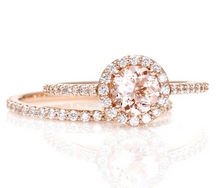 Round Stone Shape: By far the most popular choice, a round-cut stone is a safe bet in ensuring that you’re able to balance cut, color, and clarity grades without compromising on brilliance and fire.
Round Stone Shape: By far the most popular choice, a round-cut stone is a safe bet in ensuring that you’re able to balance cut, color, and clarity grades without compromising on brilliance and fire.
Shape Tip: Opt for a round-cut stone with either an ideal or very good cut grade combined with a matching ideal, excellent, or very good symmetry and polish grade.
Round Cut Engagement Ring | Rare Earth2. Princess Cut Engagement Rings
 Princess Stone Shape: This winning alternative to the traditional round shape stands out as an engagement ring fave owing to it’s unique pointed corners that usually form a square, but can also be rectangular in shape.
Princess Stone Shape: This winning alternative to the traditional round shape stands out as an engagement ring fave owing to it’s unique pointed corners that usually form a square, but can also be rectangular in shape.
Shape Tip: A princess-cut stone works well in solitaire engagement rings or with accent stones. A 4-pronged setting or cropped corners will ensure that it’s 4 pointed corners are protected.
Princess Cut Engagement Ring | Rare Earth3. Emerald Cut Engagement Rings
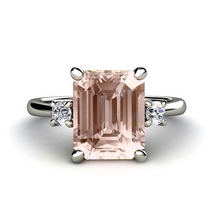 Emerald Stone Shape: An emerald-cut stone has a unique pavilion of rectangular facets that creates it’s outstanding appearance and enhances the stone’s clarity. If you fancy a more square emerald-cut stone shape, consider the unusual asscher-cut stone shape.
Emerald Stone Shape: An emerald-cut stone has a unique pavilion of rectangular facets that creates it’s outstanding appearance and enhances the stone’s clarity. If you fancy a more square emerald-cut stone shape, consider the unusual asscher-cut stone shape.
Shape Tip: Look for a length-to-width ratio between 1.30 and 1.40 for a classic emerald-cut stone.
Emerald Cut Engagement Ring | Rare Earth4. Asscher Cut Engagement Rings
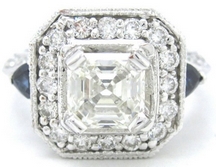 Asscher Stone Shape: A square version of the emerald-cut diamond shape, the asscher shape also features a pavilion of rectangular facets, which brings out the stone’s clarity.
Asscher Stone Shape: A square version of the emerald-cut diamond shape, the asscher shape also features a pavilion of rectangular facets, which brings out the stone’s clarity.
Shape Tip: Look for a length-to-width ratio between 1.00 and 1.05 for a classic asscher-cut stone that appears square in shape.
Asscher Cut Engagement Ring | KNR Inc.5. Marquise Cut Engagement Rings
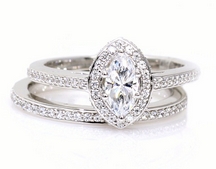 Marquise Stone Shape: Maximize your diamond’s carat weight with a brilliant-cut and finger-slimming Marquise shaped stone that makes the most of enlarging the appearance of your diamond.
Marquise Stone Shape: Maximize your diamond’s carat weight with a brilliant-cut and finger-slimming Marquise shaped stone that makes the most of enlarging the appearance of your diamond.
Shape Tip: Accent a centred marquise shaped stone with similar pear-shaped or round side stones. For a traditional marquise cut stone, search for a length-to-width ratio between 1.75 and 2.25.
Marquise Cut Engagement Ring | Rare Earth6. Oval Cut Engagement Rings
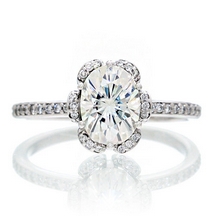 Oval Stone Shape: Just like a round stone, an oval-cut stone boasts enviable brilliance with the added bonus of accentuating those who have slender fingers.
Oval Stone Shape: Just like a round stone, an oval-cut stone boasts enviable brilliance with the added bonus of accentuating those who have slender fingers.
Shape Tip: Typical oval-cut stones have a length-to-width ratio between 1.33 and 1.66.
Oval Cut Engagement Ring | Sam n Sue7. Radiant Cut Engagement Rings
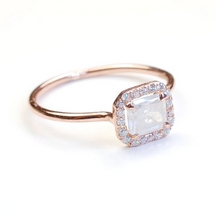 Radiant Stone Shape: A neatly trimmed rectangular or square shape with defined corners differentiates a radiant-cut from the emerald-cut shape. Round-cut side stones complement this cut very well as it allows the radiant stone shape to stand out.
Radiant Stone Shape: A neatly trimmed rectangular or square shape with defined corners differentiates a radiant-cut from the emerald-cut shape. Round-cut side stones complement this cut very well as it allows the radiant stone shape to stand out.
Shape Tip: For square radiant stone shapes, look for a length-to-width ratio between 1 and 1.05, with more rectangular radiant stone shapes having an outline ratio exceeding 1.10.
Radiant Cut Engagement Ring | Nixin8. Pear Cut Engagement Rings
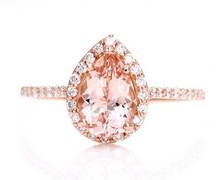 Pear Stone Shape: Featuring a single point that forms a rounded end, the pear-cut stone shape resembles a teardrop that looks stunning when adorned with a border of smaller round stones.
Pear Stone Shape: Featuring a single point that forms a rounded end, the pear-cut stone shape resembles a teardrop that looks stunning when adorned with a border of smaller round stones.
Shape Tip: Standard pear-shaped stones have a length-to-width ratio between 1.45 and 1.75.
Pear Cut Engagement Ring | Rare Earth9. Heart Cut Engagement Rings
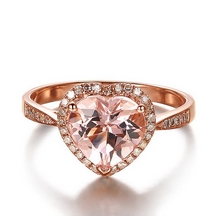 Heart Stone Shape: The romantic heart-cut stone shape symbolizes love, love and not to mention, a fitting choice for an occasion such as an engagement.
Heart Stone Shape: The romantic heart-cut stone shape symbolizes love, love and not to mention, a fitting choice for an occasion such as an engagement.
Shape Tip: Look for a length-to-width ratio between .90 and 1.10 for a traditional heart-shaped stone.
10. Cushion Cut Engagement Rings
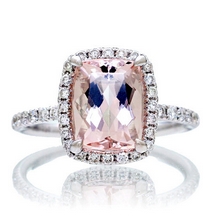 Cushion Stone Shape: A cushion-cut or pillow-cut stone shape is distinguished by larger facets and rounded corners, which enhances it’s brilliance. Cushion-cut stones vary in shapes from square to rectangular all depending on your preference.
Cushion Stone Shape: A cushion-cut or pillow-cut stone shape is distinguished by larger facets and rounded corners, which enhances it’s brilliance. Cushion-cut stones vary in shapes from square to rectangular all depending on your preference.
Shape Tip: Cushion-cut stones that are square-shaped have a length-to-width ratio between 1 and 1.05, with ratios greater than 1.15 reflecting a more rectangular shape.
Cushion Cut Engagement Ring | Sam n SueCheck out Part 1 of our Engagement Ring Guide Series, Engagement Ring Guide: Settings & Styles to find out how to choose from the different settings and styles of your engagement ring.
Handy diamond and gemstone info can be grabbed from the following ring resource, Blue Nile.
